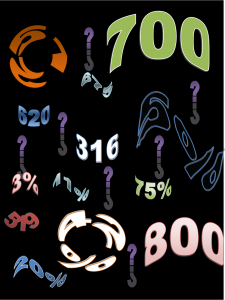
by Ricki McWilliams | Jan 27, 2015
 America Saves Week 2015 ~ February 23 – February 28
America Saves Week 2015 ~ February 23 – February 28
America Saves Week is coordinated by America Saves and the American Savings Education Council. Started in 2007, the Week is an annual opportunity for organizations to promote good savings behavior and for individuals to assess their own savings status. Typically, thousands of organizations participate in the Week, reaching millions of people. This campaign encourages individuals and families to save money and build personal wealth.
The 2014 Annual National Survey Assessing Household Savings (released during America Saves Week) revealed that while most Americans are meeting immediate financial needs, they are worse off than several years ago.
- Only about one-third of Americans feel prepared for their long-term financial future.
- 68 percent reported they are spending less than their income and saving the difference – down from 73 percent in 2010.
- Nearly two-thirds of respondents (64%) said they “have sufficient emergency savings to pay for unexpected expenses like car repairs or a doctor visit” – down from 71 percent in 2010.
- 76 percent said they are reducing their consumer debt or are consumer debt-free – down from 79 percent in 2010.
To learn more about America Saves Week and Pledge to Save, visit: www.AmericaSavesWeek.org
Set a Goal. Make a Plan. Save Automatically.
Get Involved! Events during America Saves Week include:
Ag Save$ Summit
February 23 – 9:00am CST/10:00am EST
Jackson County Extension Office, 2741 Pennsylvania Avenue, Marianna, FL 32448
(view registration link for additional locations)
FREE to register: bit.ly/AgSavesSummit
America Saves Financial Challenge – Online
February 22 – March 23
FREE to enroll: http://bit.ly/MoneyChallenge2015
Challenge Yourself to Save Money – America Saves Challenge Twitter Chat (#eXASchat)
February 24 – 2:00pm CST/3:00pm EST
Log in to Tchat.io at http://www.tchat.io/ and insert #eXASchat into the textbox that pops up so you can tweet easily and view the live Twitter stream
Where to Turn for Financial Advice – Webinar
February 25 – 11:00am CST/12:00pm EST
Free Registration: http://bit.ly/finpro2015
Personal Finance Questions – Realities & Myths – Webinar
February 26 – 11:00am CST/12:00pm EST
Free Registration: http://bit.ly/faq2015
by Kristin Jackson | Nov 22, 2014
 When you go to the doctor for a physical your health care provider probably routinely records four important numbers as a base line indicator of your health. Your vital signs consist of your blood pressure, breaths per minute, pulse and temperature. There are important numbers when it comes to your financial health as well: your credit score, debt to income ratio and your savings rate.
When you go to the doctor for a physical your health care provider probably routinely records four important numbers as a base line indicator of your health. Your vital signs consist of your blood pressure, breaths per minute, pulse and temperature. There are important numbers when it comes to your financial health as well: your credit score, debt to income ratio and your savings rate.
Your Credit Score
Your credit score is used most frequently by lenders to evaluate the risk involved when loaning you money. With your consent, your credit score could also be used when considering you for employment, insurance or housing. The normal range for a credit score used by the Fair Isaac Corporation is 300-850, but the exact scoring method is determined by your lender. You can get a free copy of your credit report (the information by which your score is determined) if you are ever denied credit or by visiting https://www.annualcreditreport.com.
Your Income to Debt Ratio
Your debt to income ratio looks at the percentage of income that goes toward paying all recurring debt payments such as credit cards, car loans or even child support. You can calculate this ratio yourself by adding up all of your debts and dividing it by your income. The National Association of Credit Unions suggest that a debt ratio of 36% or less is ideal for most people.
Savings Rate
Your savings rate is the amount of personal income expressed as a percentage that you save. Your savings rate is another figure you can calculate yourself (Total dollars saved per month / total disposable income = savings rate). In, “How Much Should We Spend,” UF IFAS Extension publication FCS5229 the recommended savings rate for your general savings, your emergency fund and miscellaneous expenses is 2-20% of your income.
If you knew your numbers and they are above par then give yourself a pat on the back if you need more information that is no problem either. Contact your UF/IFAS Extension Family Consumer Science Agent (FCS) can meet with you or your small group and explain to you in more detail what each of these numbers are, where to find these numbers and provide you with the resources you need to know where you stand. You wouldn’t ignore your vital stats, so don’t neglect financial stats either. For more information contact your UF IFAS Extension office by visiting http://solutionsforyourlife.ufl.edu/map/ or contact UF IFAS Jefferson County Extension Agent, Kristin Jackson at 850-342-0187 or jefferson@ifas.ufl.edu.
Resources:
National Institutes of Health. (2014). Vital signs Retrieve 27 August from http://www.nlm.nih.gov/medlineplus/ency/article/002341.htm
Turnner, J. (2006). How Much Should I Spend? Retrieved 27 August from http://goo.gl/d29h5r
Credit Union National Association Inc.(2014). Debt to Income Ratio. Retrieved 27 August from http://hffo.cuna.org/12433/article/316/html

 America Saves Week 2015 ~ February 23 – February 28
America Saves Week 2015 ~ February 23 – February 28
